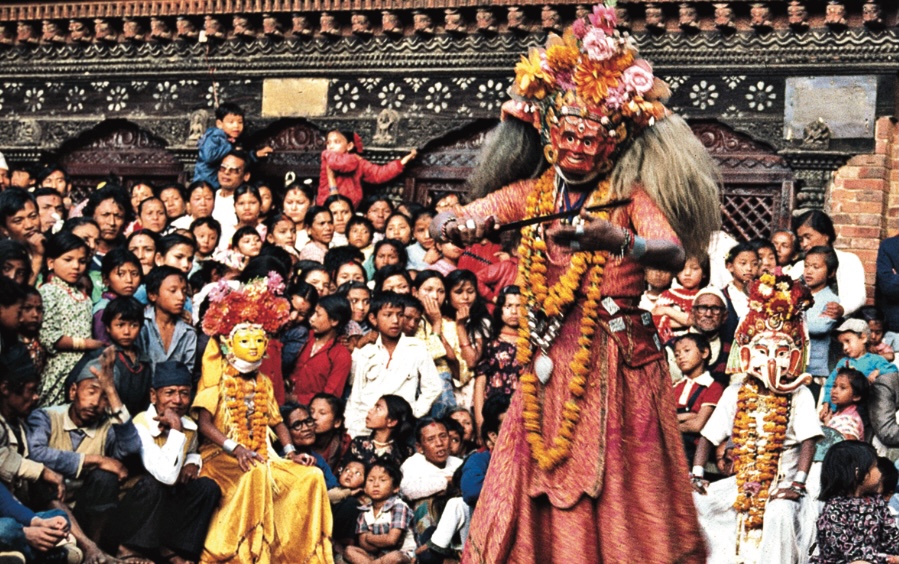BY WILLIAM FORBES
Warm, sunny days with billowy cloudscapes and kite-flying breezes melt into the first chills of winter as most of Nepal’s twenty million Hindus prepare for Dashain, the region’s longest and most auspicious religious festival. This fifteen-day celebration takes place during the month of Kartik on the Bikram Sambat calendar (late September and early October) during a bright lunar fortnight ending on a full moon day. Goddess Durga is the central focus of worship. During this time, her ardent Nepalese devotees flood Her with abundant offerings.
The first nine days of Dashain is comprised of a secondary festival called Navaratri, which is also celebrated throughout India, where it usually consists of worship offered to forms of the Goddess: Saraswati (Goddess of learning and speech), Lakshmi (Goddess of wealth and prosperity) and Durga (Goddess of strength and courage). In Nepal, Durga, in her wrathful or terrifying aspect, takes center stage.
One popular story, accepted by many as suitable justification for Durga’s wrath, tells of a battle, symbolizing the conflict of good and evil, waged between Goddess Durga and an asura named Mahisha. In this battle, Durga (good) defeats Mahisha (bad) after ten days of fighting. Today this conquest is celebrated in Nepal and throughout India as Vijaya Dasami, meaning “tenth day victory.” Vijaya Dasami is concurrently celebrated as the victory of Lord Rama over the powerful demon Ravana. In Nepal, Dashain continues after Vijaya Dasami into another five days of celebration called Kojagrat Purnima. During this time, devotees visit relatives to share festival blessings.
In preparation for Dashain, and in anticipation of Durga’s visit, villagers throughout Nepal pray, chant mantras and ceremonially cleanse their houses, covering the floors with mud, cow dung and water. Dashain is a time for both celebration and austerity. Many devotees rise early in the morning to begin an intense regime of sadhana (personal devotional practices) that sometimes lasts all day. Some perform a special penance of spending an entire night lying or sitting perfectly still with burning oil lamps attached to their arms, legs and torso.
Dashain officially begins on a new moon day called Ghatasthapana, which means, “the establishment of the sacred vessel.” (In 2005, this occurred on October 4, which happened to coincide with the Jewish New Year, Rosh Hashana, and the beginning of the Ramadan fast of the Muslims.) Early in the morning on this first day, devotees plant various grains in small vessels filled with riverbed sand. These pots, representing Goddess Durga, are watered and cared for daily in home shrines as the grains germinate and grow. When the sprouts fully emerge, after five or six days, they are used in ritual worship and worn in the hair or behind the ears as a blessing.
On the seventh day of Dashain, devotees carry their sacred vessels–now brimming with fresh greenery–from their home shrine rooms to the royal house of Gorkha, the residence of the ruling dynasty. This day is called Phulpati. It is a time of joy and splendorous fanfare when most businesses are closed so that everyone can completely enjoy the festivities.
In the evenings, thousands attend Devi temples, some carrying beautifully crafted lanterns made just for the occasion. At these temples, exotic music is performed as masked dancers enact myths associated with the Goddess.
From midnight of the eighth day, called Kalaratri (the Black Night), the sacrifices begin. Over the next three days, thousands of buffalos, goats, ducks and chickens are sacrificed to the Goddess. All the meat is distributed to devotees as prasadam (sacred offerings). It is generally believed that animals sacrificed during Dashain are reborn as humans. Many Hindus who consider this animal sacrifice to be cruel follow an alternative practice of breaking a coconut as a gesture of sacrifice.
On the ninth day, Durga is beseeched for the protection of all vehicles and their occupants. This pertains to every sort of conveyance, from luxury limos to humble bicycles. On this same day, God Vishvakarma, the heavenly architect and producer of all mechanical things, is also propitiated. All tools and implements of labor are worshiped with flowers, lights, incense and sacrifice. Students’ books, desks and pens; carpenters’ hammers and chisels; doctors’ scalpels; plumbers’ wrenches; computers–all receive sanctification. Marxists even have their hammer and sickle blessed.
On the tenth day, Vijaya Dasami, devotees receive the tika from elder relatives and superiors. This tika is a red mark made of vermilion paste applied to the forehead as a benediction. From early in the morning, people line up in front of the Royal Palace to receive this sacred mark from the King and Queen of Nepal. First, the King receives tika in the early morning from his Royal guru. This is accompanied by a 31-gun salute. He then bestows the tika on his family, the Prime Minister and other high officials. Then the public is allowed to come forward into the palace grounds for their opportunity to receive the tika right from the hands of the monarch. This event continues throughout the day.
For the next five days, everybody visits relatives–receiving and giving tika, giving gifts, exchanging greetings and feasting. On the final full-moon day, Buddhists, who have been praying for the suffering of the world, participate in a day-long procession, during which they visit various shrines to scatter grains, coins and foodstuffs to bring peace to the souls of the dead.
This full moon day is known as Kojagrata, which means, “one who is awake.” At this time, the worship of Durga, in Her wrathful aspect ends, and Lakshmi, the Goddess of Wealth, is worshiped for prosperity, happiness and well-being. Life returns to normal, offices open, people go back to work, pilgrims return home. According to Nepalese tradition, those who observe the festival of Dashain acquire virtue, power, wealth and many offspring–even as they escape the miseries of evil and sin.


